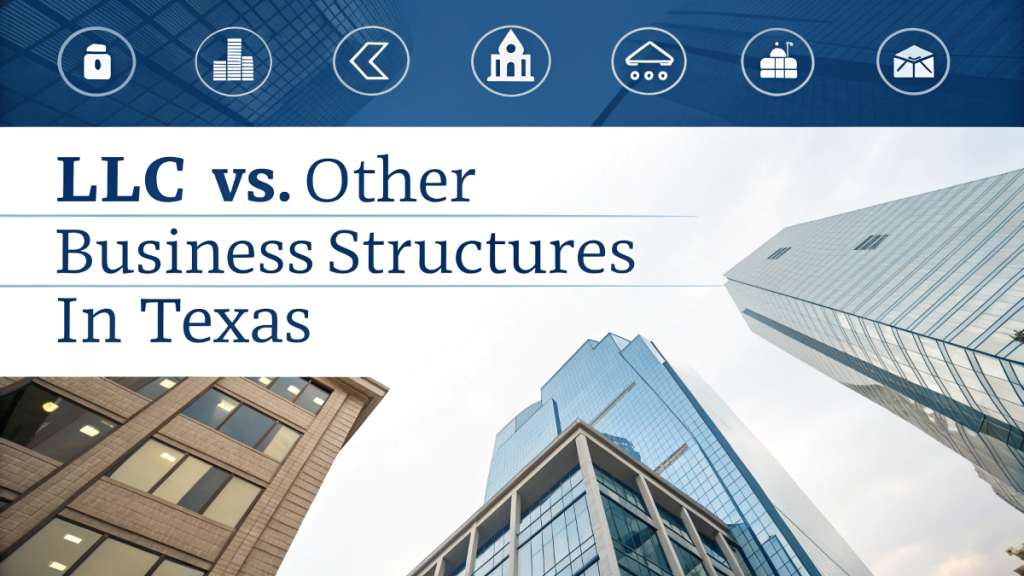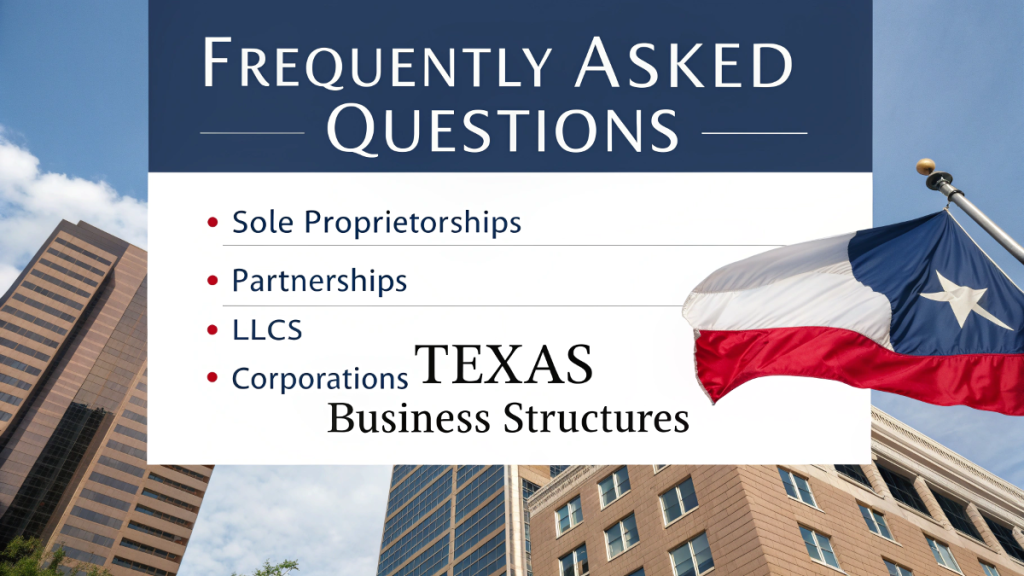Choosing the correct legal structure is the most critical decision for a Texas business, influencing liability, tax, and administration. The Texas Business Organizations Code offers several options LLC, Sole Proprietorship, General Partnership, and Corporations (S or C) each with distinct pros and cons. The LLC is highly popular for combining corporate liability protection with the simplicity of pass-through taxation. This guide simplifies the strategic differences to help entrepreneurs establish a resilient and compliant structure.

Before registering a new business in Texas, it’s essential to perform a thorough Texas Secretary of State entity search. This ensures your desired business name is available and avoids conflicts with existing entities, helping maintain compliance and protecting your corporate identity from potential legal challenges.
The Limited Liability Company (LLC) Advantage
Strong Personal Liability Shield
The LLC structure legally separates the business entity from its owner (member), creating a personal liability shield. In cases of business debt or lawsuits, liability generally rests with the company’s assets, protecting the members’ personal wealth.
However, this shield is not absolute. Owners must maintain corporate formalities and avoid co-mingling funds to prevent courts from “piercing the corporate veil.”
Flexible Tax Treatment
The LLC offers unmatched federal tax flexibility. By default, it uses pass-through taxation, where income and expenses are reported on the owner’s personal return (Schedule C for single-member).
Crucially, an LLC can elect to be taxed as an S-Corporation or C-Corporation by filing with the IRS. This allows the business to adapt its tax strategy for potential self-employment tax savings without changing its legal structure.
Simplified Administration
The LLC requires significantly less administrative oversight than a Corporation, making it ideal for small to medium businesses. Formal board meetings or complex stock issuance rules are generally not mandatory.
The primary internal document is the Operating Agreement (OA), which defines member rights, management roles, and profit distributions. Though often not legally mandated, a written OA is essential for clarity and liability protection.
Texas Franchise Tax Application
All LLCs are classified as “taxable entities” and must comply with the Texas Franchise Tax (margin tax). This requires filing an annual Franchise Tax Report and a Public Information Report (PIR) with the Comptroller.
Many new LLCs fall below the “No Tax Due” revenue threshold and owe zero tax, but filing the reports is still mandatory. Failure to file leads to loss of “good standing” status and potential fines.
Sole Proprietorships and General Partnerships
Lack of Personal Asset Protection
These are the simplest forms, but they have no legal separation; the owner is the business. The Sole Proprietorship and General Partnership offer no liability shield.
Owners or partners are personally liable for all business debts, contracts, and legal judgments. This exposes personal assets, such as homes and savings, making them high-risk options.
Direct Pass-Through Taxation
Both structures use the simplest form of pass-through taxation, reporting income directly on the owners’ personal tax returns (Schedule C or K-1).
The major financial drawback is that owners must pay self-employment tax on all net earnings, which is less tax-efficient than the S-Corp model for profitable ventures.
Minimal Administrative Requirements
These structures have the lowest administrative burden, requiring no Certificate of Formation with the SOS.
The only formal state requirement is filing an Assumed Name Certificate (DBA) with the county if the business uses a name other than the owner’s legal name. Partnerships should, however, use a detailed Partnership Agreement for internal governance.
Corporations (S-Corp and C-Corp)
Absolute Separation and Formalities
The Corporation provides the gold standard for liability protection but demands a rigorous commitment to corporate formalities. It requires a Board of Directors, officers, and shareholders.
Mandatory compliance includes establishing Bylaws and holding formal, documented annual meetings. Failure to maintain these ongoing formalities severely jeopardizes the liability shield.
C-Corporation and “Double Taxation”
The C-Corporation is the default corporate structure and the only one subject to “double taxation.” The corporation pays income tax on its profits, and shareholders pay a second tax on dividends distributed.
Despite this inefficiency, the C-Corp is required for large companies and those seeking major institutional equity investment, as it can issue multiple classes of stock.

S-Corporation for Efficient Pass-Through
The S-Corporation is a federal tax election that operates legally as a Corporation but eliminates double taxation by adopting pass-through taxation.
It offers tax efficiency by allowing owner-employees to take a “reasonable salary” (subject to payroll tax), while remaining distributions are generally exempt from self-employment tax.
Key Comparative Factors
Preserving the Liability Shield
To avoid “piercing the corporate veil,” formal entities must strictly separate finances, maintain adequate capitalization, and document all major decisions. The LLC’s less rigid requirements make compliance easier than the Corporation’s.
Capital Formation
The C-Corporation is built for external equity fundraising and is preferred by Venture Capitalists. The LLC is better for simpler equity deals, while Sole Proprietorships and Partnerships rely on owner capital and personally guaranteed loans.
Exit Strategy and Transferability
The Corporation offers the smoothest transferability via shares of stock. The LLC’s transferability is governed by its Operating Agreement; default rules often require all members’ consent for a sale.
Comparative Tax Efficiency
The S-Corporation election offers the best tax efficiency for profitable pass-through entities by reducing self-employment tax liability. The Texas Franchise Tax applies to all formal entities (LLCs and Corporations), making it a constant administrative factor regardless of structure choice.
FAQs on Texas Business Structures

What is the primary difference in liability between an LLC and a Sole Proprietorship?
The LLC provides a limited liability shield, protecting the owner’s personal assets (home, savings) from business debts. The Sole Proprietorship has full personal liability, meaning the owner’s personal assets are legally exposed to business creditors and lawsuits, as the owner and business are legally inseparable.
Can a Texas LLC elect to be taxed as an S-Corporation?
Yes, an LLC can elect S-Corporation tax status by filing IRS Form 2553. This is a strategic move for profitable LLCs, allowing the owner to pay self-employment tax only on a reasonable salary, with remaining distributions generally exempt. This offers tax savings without altering the LLC’s state-level legal structure.
What are the main disadvantages of a C-Corporation for a small Texas business?
The primary disadvantage is “double taxation.” The C-Corporation pays corporate income tax on its profits, and then shareholders pay personal income tax again on any dividends received. This tax inefficiency makes the C-Corp a poor choice for most small businesses unless they plan for significant venture capital investment or an IPO.
How does the Texas Franchise Tax affect Sole Proprietorships?
The Texas Franchise Tax (margin tax) generally does not affect a true Sole Proprietorship because it is not considered a “taxable entity” under state law. Therefore, Sole Proprietors are exempt from filing the annual Franchise Tax Report and the Public Information Report (PIR), simplifying their state-level compliance significantly.
What administrative formalities are mandatory for a Texas Corporation but optional for an LLC?
A Texas Corporation must legally establish Bylaws and hold formal, documented annual meetings for its Board and shareholders to preserve its liability shield. While recommended for good practice, these formal meeting and documentation requirements are generally not mandatory for an LLC under the Texas Business Organizations Code.
What is “piercing the corporate veil,” and how can it be avoided in Texas?
“Piercing the corporate veil” is a legal action where a court removes the liability protection of an LLC or Corporation, holding owners personally responsible for debts. It is avoided by strictly separating business and personal finances (no co-mingling), ensuring adequate capitalization of the business, and consistently observing all legal formalities (e.g., proper contract execution).
What is the primary legal document governing a Texas General Partnership?
The primary legal document is the Partnership Agreement. Although a partnership can form informally, a detailed, written agreement is essential. It defines partners’ capital contributions, profit-sharing ratios, management authority, and procedures for dispute resolution or partner exit, preventing the application of potentially unfavorable state default rules.
How does the LLC structure impact the transferability of ownership interests?
The transferability of membership interests in an LLC is determined by its Operating Agreement (OA). If the OA is silent, Texas default rules often require the unanimous consent of all other members for any transfer. Therefore, clear, explicit terms regarding the sale or assignment of interests must be defined within the OA to ensure smooth transferability.
Which structure is best suited for a small business that anticipates seeking venture capital?
The C-Corporation is overwhelmingly the best structure for businesses anticipating seeking Venture Capital (VC) funding. VCs prefer the C-Corp because it is the standard vehicle for institutional investment, allowing for flexible stock issuance and alignment with the structural requirements for a future Initial Public Offering (IPO).
What is the role of an Assumed Name Certificate (DBA) for a Texas Corporation?
The Assumed Name Certificate (DBA), or “Doing Business As,” is filed by a Texas Corporation to provide public notice that the legal entity is operating under a name different from its formal, registered name. The corporation must file the DBA with both the Texas Secretary of State and the county clerk’s office in every relevant county.
